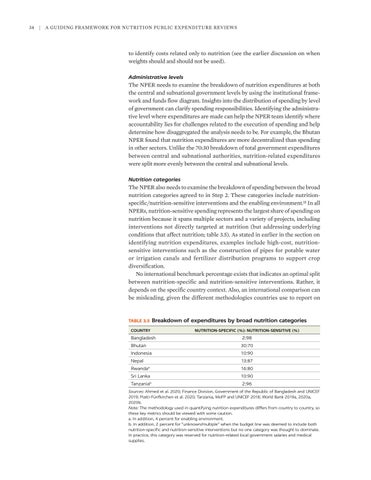34
| A Guiding Framework for Nutrition Public Expenditure Reviews
to identify costs related only to nutrition (see the earlier discussion on when weights should and should not be used). Administrative levels
The NPER needs to examine the breakdown of nutrition expenditures at both the central and subnational government levels by using the institutional framework and funds flow diagram. Insights into the distribution of spending by level of government can clarify spending responsibilities. Identifying the administrative level where expenditures are made can help the NPER team identify where accountability lies for challenges related to the execution of spending and help determine how disaggregated the analysis needs to be. For example, the Bhutan NPER found that nutrition expenditures are more decentralized than spending in other sectors. Unlike the 70:30 breakdown of total government expenditures between central and subnational authorities, nutrition-related expenditures were split more evenly between the central and subnational levels. Nutrition categories
The NPER also needs to examine the breakdown of spending between the broad nutrition categories agreed to in Step 2. These categories include nutrition- specific/nutrition-sensitive interventions and the enabling environment.15 In all NPERs, nutrition-sensitive spending represents the largest share of spending on nutrition because it spans multiple sectors and a variety of projects, including interventions not directly targeted at nutrition (but addressing underlying conditions that affect nutrition; table 3.5). As stated in earlier in the section on identifying nutrition expenditures, examples include high-cost, nutrition- sensitive interventions such as the construction of pipes for potable water or irrigation canals and fertilizer distribution programs to support crop diversification. No international benchmark percentage exists that indicates an optimal split between nutrition-specific and nutrition-sensitive interventions. Rather, it depends on the specific country context. Also, an international comparison can be misleading, given the different methodologies countries use to report on
TABLE 3.5
Breakdown of expenditures by broad nutrition categories
COUNTRY
NUTRITION-SPECIFIC (%): NUTRITION-SENSITIVE (%)
Bangladesh
2:98
Bhutan
30:70
Indonesia
10:90
Nepal
13:87
Rwandaa
16:80
Sri Lanka
10:90
Tanzaniab
2:96
Sources: Ahmed et al. 2020; Finance Division, Government of the Republic of Bangladesh and UNICEF 2019; Piatti-Fünfkirchen et al. 2020; Tanzania, MoFP and UNICEF 2018; World Bank 2019a, 2020a, 2020b. Note: The methodology used in quantifying nutrition expenditures differs from country to country, so these key metrics should be viewed with some caution. a. In addition, 4 percent for enabling environment. b. In addition, 2 percent for “unknown/multiple” when the budget line was deemed to include both nutrition-specific and nutrition-sensitive interventions but no one category was thought to dominate. In practice, this category was reserved for nutrition-related local government salaries and medical supplies.

